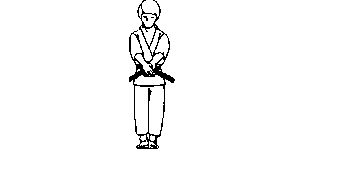 |
Kata/Hyung
Kata (型 or 形, literally: "Form") is a Japanese word describing detailed choreographed patterns of movements practised either solo or in pairs. The term form is used for the corresponding concept in non-Japanese martial arts in general. |
|
Kata are used by most traditional Japanese and Okinawan martial arts, such as aikidō, iaidō, jōdō, jūdō, jūjutsu, kenjutsu, kendō and karate. Other arts such as t'ai chi ch'uan and taekwondo feature the same kind of training, but use the respective Chinese and Korean words taolu and hyung, respectively. Like Kumite, Kata forms a significant aspect of gradings where the student must demonstrate correct application, speed and power of the techniques.
Kata are prearranged sets of movements and techniques, in the execution of which you defend against several hypothetical attackers. As you practice kata, you will discover several interesting truths.
- First, kata are intended to build your strength and balance, and to help you work on the timing and coordination of different techniques. You will learn to execute techniques with speed and power, and to practice moving in stances.
- Secondly, kata requires you to focus inwards and to concentrate on the emotional and psychological aspects of karate, since each kata is more than simply a collection of exercises or physical movements. It’s fair to say that at least half of the proper execution of kata takes place in your head.
- Finally, you will discover that your grasp of kata has direct bearing on your skills as a fighter, at least in part because the constant practice of kata shapes your attitude on one level, and reinforces critical muscle memory on another level.
Use the grey links to access a movie or diagram of each of SEFKA's Kata
|
|
Video of Kata |
Updated Diagrams |
|
|
|
|
|
|
|
|
|
|
|
|
|
|
|
|
|
|
|
|
|
|
|
|
|
|
|
|
|
|
|
|
|
|
|
|
|
|
|
|
Chal Gi |
Black 3rd Dan |
|
|

This animation is the kata Chal Gi - which is performed for 3rd dan
|